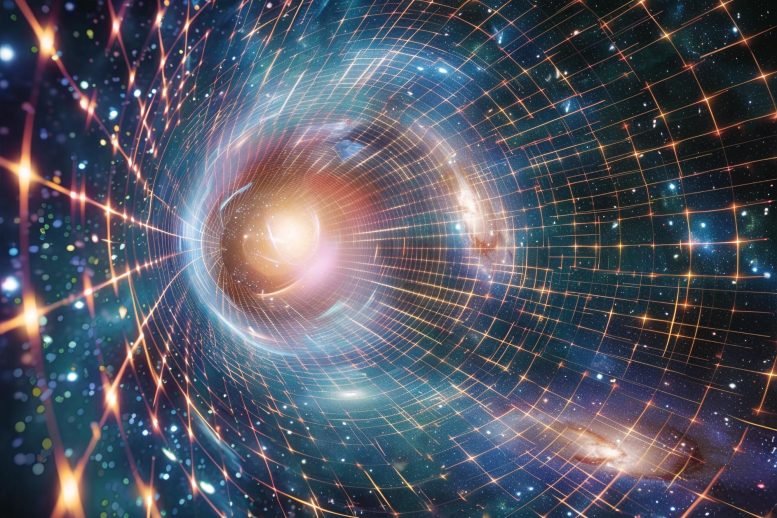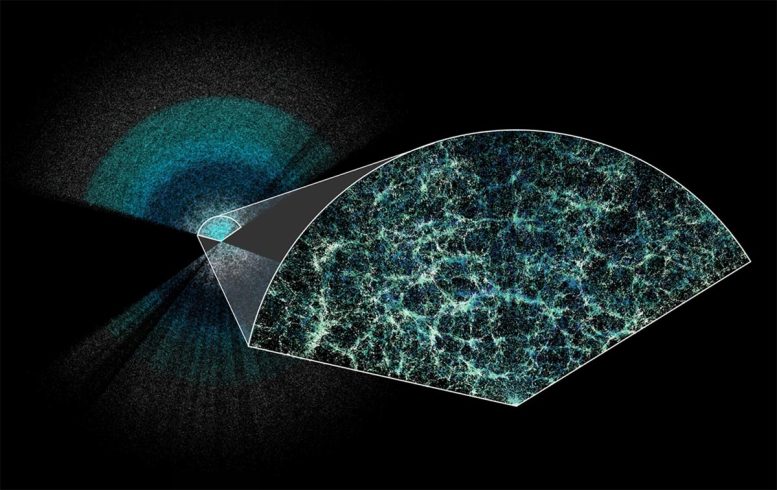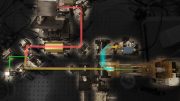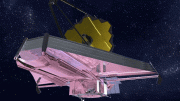
The DESI collaboration is conducting a groundbreaking experiment to understand the universe’s expansion and acceleration. Their work with the DESI instrument has enabled them to map the cosmos from its early stages to the present, challenging existing models of the universe. Initial findings suggest there may be more to discover about dark energy and cosmic acceleration. The project’s innovative approach, including a fully blinded analysis, ensures that their conclusions are based on unbiased data, paving the way for future discoveries in astrophysics. Credit: SciTechDaily.com
The DESI collaboration is examining the universe’s accelerating expansion through comprehensive mapping from its early stages to the present. Their findings challenge traditional cosmic models and suggest new insights into dark energy, all while utilizing groundbreaking, unbiased research methods.
A team of researchers, including an astrophysicist from The University of Texas at Dallas, as part of the Dark Energy Spectroscopic Instrument (DESI) collaboration, is leading a groundbreaking experiment aimed at exploring the universe’s expansion and acceleration.
Dr. Mustapha Ishak-Boushaki, professor of physics in the School of Natural Sciences and Mathematics (NSM) at UT Dallas, is a member of the DESI collaboration, an international group of more than 900 researchers from over 70 institutions around the world engaged in a multiyear experiment to increase understanding of the history and fate of the cosmos.
On April 4, Ishak-Boushaki presented analyses of the first year of data collected by the DESI experiment at a meeting of the American Physical Society in Sacramento, California, along with two other DESI scientists. Ishak-Boushaki presented the cosmology results inferred from DESI data and their implications for the universe. Researchers also shared results from the first year of collected data in multiple papers posted on the preprint site arXiv.
The Role of the DESI Instrument
The DESI instrument, located at Kitt Peak National Observatory (KPNO) in Arizona, gathers light from the most distant parts of the universe, which enables scientists to map the cosmos as it was in its youth and trace its evolution to what is observed today. Understanding how the universe has evolved is tied to how it ends and to one of the biggest mysteries in physics: What is behind the observation that the expansion of the universe is accelerating?
The analysis of DESI’s first year of data collection confirmed the basics of what scientists hold as the best model of the universe, but it also hints that there is more to learn about the underlying cause, or causes, of cosmic acceleration, the discovery of which led to the Nobel Prize in physics in 2011.

DESI has made the largest 3D map of our universe to date. Earth is at the center of this thin slice of the full map. In the magnified section, it is easy to see the underlying structure of matter in our universe. Credit: Claire Lamman/DESI collaboration; custom colormap package by cmastro
Cosmic acceleration is problematic because it counters how gravity, which causes objects with mass to be drawn together, is observed to work in our solar system and nearby space.
“Gravity pulls matter together, so that when we throw a ball in the air, the Earth’s gravity pulls it down toward the planet,” Ishak-Boushaki said. “But at the largest scales, the universe acts differently. It’s acting like there is something repulsive pushing the universe apart and accelerating its expansion. This is a big mystery, and we are investigating it on several fronts. Is it an unknown dark energy in the universe, or is it a modification of Albert Einstein’s theory of gravity at cosmological scales?”
Exploring Dark Energy and the Universe’s Expansion
Dark energy is thought by many scientists to play a key role in cosmic acceleration, but it is not well understood. Some theorize that it is a cosmological constant – an intrinsic property of space that drives the acceleration.
To study dark energy’s effects over the past 11 billion years, the DESI group has created the largest 3D map of the cosmos ever constructed using the most precise measurements to date. This is the first time scientists have measured the expansion history of the young universe with a precision better than 1%.
The leading model of the universe is known as Lambda-CDM. It includes both ordinary matter and a rarely interacting type of matter called cold dark matter (CDM) and dark energy, known as Lambda. Both matter and dark energy shape how the universe expands, but in opposing ways. Through gravitational attraction, matter and dark matter slow down the expansion, while dark energy speeds it up. The amount of each influences how the universe evolves. This model is effective at validating results from previous experiments and describing how the universe looks throughout time, Ishak-Boushaki said.
This animation shows how baryon acoustic oscillations act as a cosmic ruler for measuring the expansion of the universe. Credit: Claire Lamman/DESI collaboration and Jenny Nuss/Berkeley Lab
When DESI’s first-year results are combined with data from other studies, however, there are some subtle differences from what the Lambda-CDM model would predict.
“Our results show some interesting deviations from the standard model of the universe that could indicate that dark energy is evolving over time,” Ishak-Boushaki said. “The more data we collect, the better equipped we will be to determine whether this finding holds. With more data, we might identify different explanations for the result we observe or confirm it. If it persists, such a result will shed some light on what is causing cosmic acceleration and provide a huge step in understanding the evolution of our universe.”
More data will also improve DESI’s other early results, which weigh in on the Hubble constant – a measure of how fast the universe is expanding today – and the mass of particles called neutrinos.
Importance of Blind Analysis in Research
DESI is the first spectroscopic experiment to perform a fully blinded analysis, which conceals the true result from the scientists to avoid any subconscious confirmation bias. Researchers work “blind” with modified data and write computer code to analyze their findings. Once everything is finalized, they apply their analysis to the original data to reveal the actual answer.
“Dr. Ishak-Boushaki’s research and his collaboration with scientists at some 70 institutions is revealing important insights about our universe, and the results are fascinating,” said Dr. David Hyndman, dean of NSM and the Francis S. and Maurine G. Johnson Distinguished University Chair. “It’s inspiring to have such world-class research programs at UT Dallas and to see our scientists play key roles in fundamental discoveries.”
Reference: “Year 1 Cosmology Results” by DESI Collaboration et al., 4 April 2024.
DESI was constructed and is operated with funding from the Department of Energy (DOE) Office of Science and sits atop the National Science Foundation’s (NSF) Nicholas U. Mayall 4-meter Telescope at KPNO, which is operated by the NSF’s NOIRLab. The DOE’s Lawrence Berkeley National Laboratory manages the DESI experiment.
DESI is also supported by the National Energy Research Scientific Computing Center, the primary computing facility for the DOE Office of Science. Additional support for DESI is provided by the NSF; the Science and Technology Facilities Council of the United Kingdom; the Gordon and Betty Moore Foundation; the Heising-Simons Foundation; the French Alternative Energies and Atomic Energy Commission; the National Council of Humanities, Sciences, and Technologies of Mexico; the Ministry of Science and Innovation of Spain; and DESI member institutions.
The DESI collaboration is honored to be permitted to conduct scientific research on Iolkam Du’ag (Kitt Peak), a mountain with particular significance to the Tohono O’odham Nation.









Already under the impression that most astrophysicists are ‘blind,’ what’s new? As posted previously, in 2009 as just a lay observer I found on my own that gravity is induced by some higher force to radiate from all matter in expanding fields of pulsing coherent angular lines of attractive force. That explains the scattered dots in classic double-slit experiments better than a duality of matter and waves. Also, rotation increases the intensity of the field generated. Where, I believe, the ‘blindness’ comes in is in failing to see that photons will accelerate (blueshift) on less-dense individual lines of gravity force in expanding fields when leaving their sources and will decelerate (redshift) on more-dense individual lines of gravity force in our own contracting field of gravity when arriving to earth. Especially with redshift being observed in all directions in space, it stands to reason for me that the farther a cosmic object is away from the earth the greater it’s redshift will appear when its light arrives here. So, where’s the need for balancing dark energy against dark matter when, for all we know, the universe may have already achieved stasis?
What in the everliving Christ are you on about?
There no “lines” of gravity force. There are no lines of any force. They are a notional construct indicating the density of a field, analogous to the lines of altitude on map indicating height.
*a map
Call the Nobel committee.r
About time, r, unless some professional scientist(s) with access to some of the now tens of billions of US dollars spent on related research can prove amateur scientist me, with my tens of US dollars research (e.g., https://odysee.com/@charlesgshaver:d/1Gravity:8), wrong. Can anyone else better explain the scattering of dots in the double-slit experiments without inventing a whole new universe? Thanks for the comment.
“Can anyone else better explain the scattering of dots in the double-slit experiments…”
Yes.
Gravity of ordinary or visible matter is distinct as guided by the rotation;this is so different than the gravity of common matter on the scale of stars and galaxy,when they expand with linear motion or in experiments treated with static bias.
WUT
Now if time slows down in a logarithmic manner, everything else appears to be accelerating. Ho hum………..relatively speaking. So the older the bit of universe we see, the faster it is leaving us behind..
Dark energy is what remains from the effect of leaving our previous universe. It is where we stared 10 minutes before the singularly that transformed our universe into our own cosmos. We too give birth to new cosmos when energy exceeds the bounds of light and time.
Reply to all: similar to Nikola Tesla discovering how to make the 3-phase AC motor work in his day, in 2009 I awoke from a dream with a mental image of the entire earth radiating its lines of gravity force out across the universe. Then, it took me until 2012 to devise, perform and make a first low-budget video of rotating wheels to demonstrate the angular, independent nature of those lines of gravity force (e.g., think angular blades on a boat propeller in a body of water) hoping to convince more authoritative professional others of my lay finding; NOT! Despite decades already of observing that gravity can affect photons (e.g., gravity lensing) as they travel across the universe and through various fields of gravity, it just doesn’t seem to occur to scientists that individual lines of gravity force can affect the motions of individual photons.
Simply put, as a former industrial electrician, I know from experience that it takes an alternating or pulsating current to induce an equivalent current in another conductor (e.g., eddy-current brake/clutch) so it’s obvious to me that lines of gravity force pulse in a particular direction, which can cause a rotating wheel to precess in one direction or the other depending upon the direction of its angular velocity. So, is it that difficult to see that pulsating lines of gravity force can alter the direction of photons, electrons and large molecules in classic double-slit experiments to cause the scattered dot effect? All new science should begin with questioning all that preceded it, including questionable Einstein era dogma. Thanks for the additional stimulation.
Supposedly sane scientists are looking for something outside our laws of physics (something invisible that pushes things apart) utilizing our very laws of physics. These are bankrupt ideas. Cosmologists are running scared because if the Lambda-CDM Model goes, there’s nothing left for them.